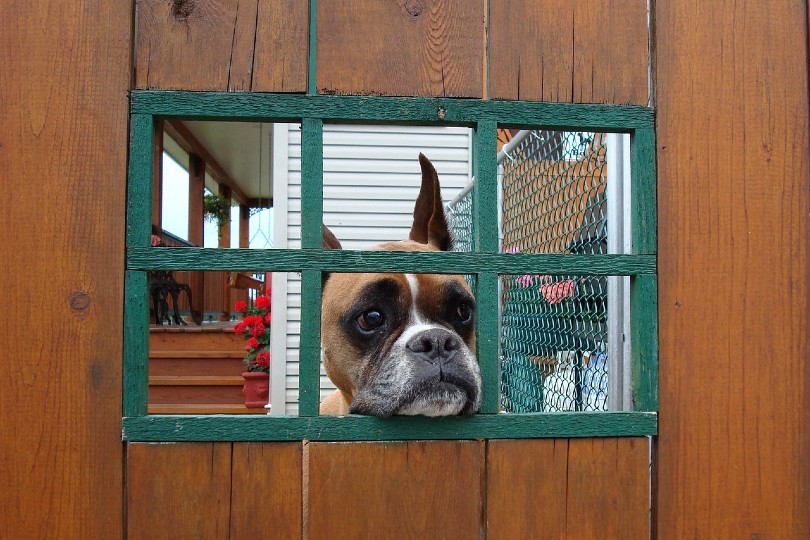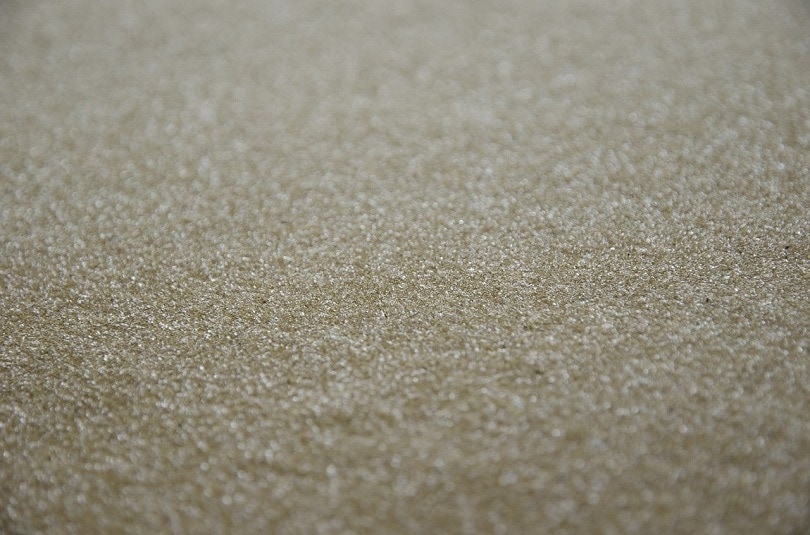How to Fix Dog Scratches on a Wood Door: 10 Expert Tips
Updated on

Click to Skip Ahead
We love our pets. However, some behaviors test our resolve, whether it’s a cat scratching your furniture or your dog putting the hurt on your wood doors. A study by the University of Helsinki found that 73% of canines displayed at least one unwanted trait. Interestingly, the researchers documented similar patterns of behaviors occurring simultaneously in dogs as in people.1
Our guide will address the practical matter of dealing with the damage done to your door. We’ll also provide additional information on getting to the root of the problem to avoid a repeat performance. It might involve simple behavioral modification techniques. It can also point to a more serious mental health condition worth investigating.
The 10 Tips for How to Fix Dog Scratches on a Wood Door
1. Clean the Area Before You Start
Do yourself a big favor and clean the scratched area before you start the fix. It’ll help you see the extent of the damage better. It’ll also make it easier to apply any repair materials or stains. We have several suggestions about how to tackle the problem based on its severity. However, the chances are your dog has been scratching on the door longer than you may have realized.
2. Use a Restoration Pen for Light Scratches

If you’re only dealing with light scratches, you can probably get away with just using a restoration pen. It probably won’t be sufficient if there are deep gouges in the wood. However, it’s a quick and effective fix. We suggest keeping one around the house for touch-ups as necessary. Bear in mind that you might not get an exact fix. The goal is to ensure you don’t make the scratches more noticeable.
3. Use a Wax Filler Crayon for Deeper Scratches
A wax filler crayon can get the job done if your dog has done more extensive damage to the door. The same considerations apply as our last entry. Warming it will make it easier to repair the damage. Using a scraper over the filled-in area will help it blend in with the existing wood after the material has solidified. You can also use one with scuff marks and light scratches.
4. Erase the Scratches with a Putty Knife and Wood Filler

If you’re dealing with large gouges, you’ll have to bring out the big guns. You can use wood filler to repair the scratches, with a putty knife to smooth out the paste. Once it’s dry, you can sand it to make it even with the wood. The curing time is usually about an hour. Staining the area will hide your fix. Some products contain wood fibers to make them seamless with no change in consistency.
5. Give Bondo a Try
You probably associate Bondo with cars. It turns out that it can do the job of fixing a wood door, too. Make sure to opt for the wood filler product instead of the stuff you use on vehicles. That one contains plastic and may crack under pressure with wood. The procedure is similar to using filler. You cover the cracks, smooth them out, sand them, and stain them to hide the repair.
6. Opt for a Lighter Stain Color Than the Existing Door

Staining is a part of many of our tips. It’s the key to making the repair unnoticeable. That’s why we suggest erring on the side of the lighter when choosing the shade. You can’t go back if your work sticks out because the stain is too dark.
7. Match the Door’s Finish
The chances are your door also has a finish. Make sure to match it, whether it’s matte or shiny. It will help ensure the repair blends in with the rest of the door. It may seem like overkill, but we recommend not skipping this step if it applies to your situation. The finish adds another protective layer on your door that can keep scratches at bay.
8. If Sanding the Door, Don’t Forget to Cover the Nearby Stuff

Sanding is a necessary step, no matter what size the repair is. However, we learned the hard way that you should cover the floor and nearby items before you start. Trust us when we say the dust goes everywhere. The bigger the job, the more essential is this simple prep. Repairing scratches on a wood door isn’t a difficult job, especially if you make cleanup easy.
9. Wipe the Sanded Area Before Staining the Wood
The dust from sanding will stick to everything, including the surface you’re repairing. Wiping the area down will allow you to assess your work and make adjustments as necessary. It’ll also help the stain adhere to the wood and draw less attention to the repair. Make sure to use a damp cloth to prevent water stains.
10. Prevent Future Problems
The best way to fix dog scratches is to prevent them from occurring in the first place. The responsibility rests on you as a pet owner to step up to the plate. A pup doesn’t engage in this behavior for a reason. It’s your responsibility to determine what’s going on and take steps to ensure it doesn’t happen again.

Tips for Preventing Scratched Doors in the Future
Let’s start with some practical ways to prevent scratched doors. It doesn’t take a rocket scientist to figure out that deep gouges come from long nails. Therefore, you must keep your pet’s nails trimmed. You can make checking them a part of your grooming routine. Walking your dog on pavement will also help with the surface acting like a file.
A dog will often scratch a door to get outside or get back in the house. If possible, you can avert the issue by installing a doggie door. Of course, doing so brings other responsibilities, such as locking the egress when not in use. Alternatively, you can put up a gate as a barrier to your pup getting to the door. Be sure to place it far enough to prevent scratching but not too wide for your dog to scale it.
It’s also essential to look at other reasons a pet might scratch a door. Unwanted behavior puts training your dog at the forefront. You can use the “no” command for other things than not chewing your shoes. However, it’s also imperative to determine if your dog’s scratching is anxiety related. Up to 20% of canines have separation anxiety, and destructive behavior usually occurs within 30 minutes of being left alone.
It’s often accompanied by other bad habits, such as inappropriate elimination, howling, and pacing. Separation anxiety can have genetic roots. It may also stem from separation from the pup’s littermates and mother. Even a lack of physical activity and the accompanying mental stimulation can make a pet more prone to this condition.
Therefore, it’s essential not just to fix your door but find out what’s causing this unwanted behavior. Your dog isn’t being spiteful; they are upset and acting on these negative emotions. Remember that dogs are capable of experiencing fear, anger, and distress. We strongly urge you to discuss behavioral issues with your vet.
Conclusion
Canines are well-equipped to hunt and ward off competitors. Unfortunately, they can also direct these actions toward your stuff, like wood doors. Repairing the damage is easy and an afternoon DIY job. The bigger question is finding the cause and determining a solution. It’s a worthwhile investment in your time and effort to improve the quality of life for your canine BFF.
Related Read:
- 8 Best Door Protectors for Dog Scratches: Reviews & Top Picks
- How to Stop a Dog from Scratching Doors: 9 Simple Practices
Featured Image Credit: JudaM, Pixabay












